
Ressources / Guide / Heat Stress Monitors: How They Work, Top Models & More
Guide
Heat Stress Monitors: How They Work, Top Models & More
A heat stress monitor—also called a WBGT meter or thermal stress monitor—is a portable device that measures environmental and physiological factors such as temperature, humidity, and radiant heat to assess heat exposure risk.
→ Jump to the best heat stress monitor of 2025.
Heat stress monitors are key environmental monitoring tools that help prevent the risks of extreme heat by tracking key conditions—like temperature, humidity, and heart rate—to warn when conditions become unsafe.
Extreme heat poses serious risks for workers in a broad range of industries, including oil and gas, manufacturing, and utilities.
As heat-related incidents rise, and OSHA moves toward stronger heat safety standards, these devices are becoming essential tools for workplace safety.
Other common terms for heat stress monitors include:
- Heat stress meters
- Thermal stress monitors
- Body temperature monitors
- Heat safety devices
- Personal heat exposure monitors
In this guide, we’ll cover how heat stress monitors work, the main types used in industrial settings, what the latest OSHA guidance says, and more.
Use the menu to the right to jump around, or keep reading for the full guide.
Best Heat Stress Monitors for Sale [New for 2025] + More Environmental Monitoring Solutions
Want to buy or rent a heat stress monitor? Or looking for other environmental solutions? Keep reading for the top options on the market. Note: Our solutions support compliance with OSHA and ISO standards and include rental and purchase options with expert calibration and technical support.1. QUESTemp 44/46/48N—Heat Stress Monitor
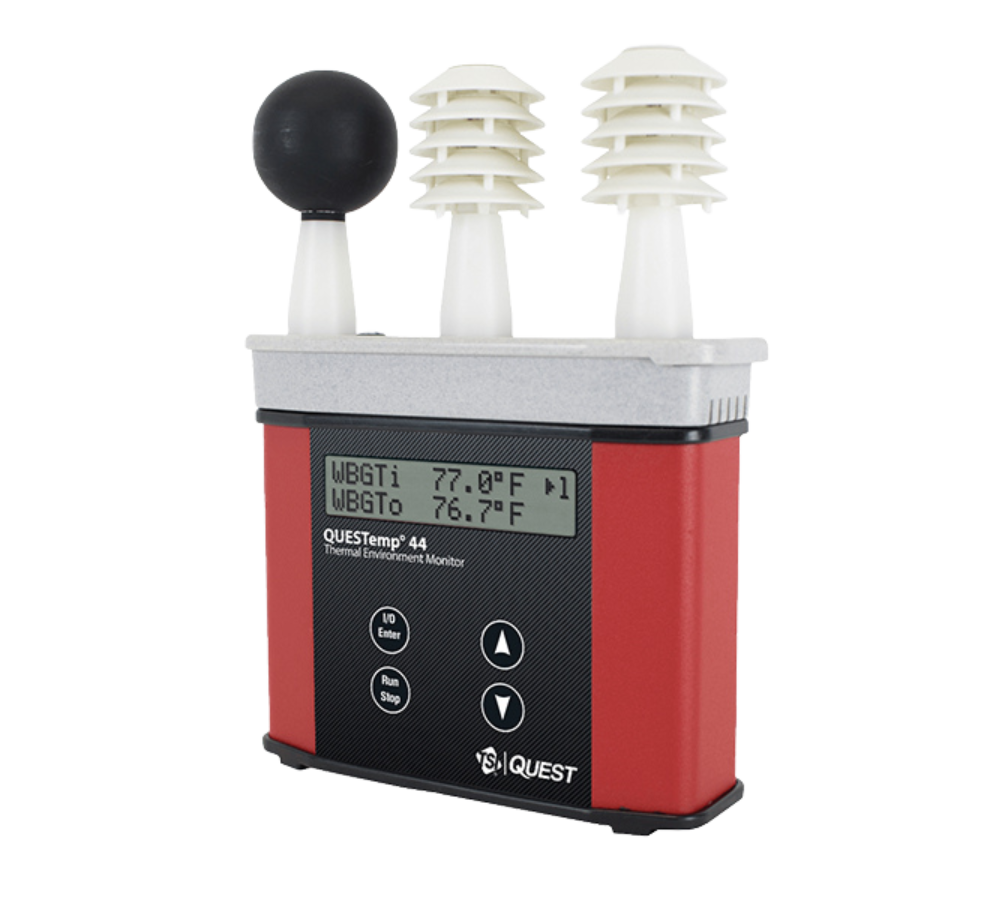 The TSI QUESTemp 44/46/48N Series provides accurate, real-time measurement of Wet Bulb Globe Temperature (WBGT), air temperature, humidity, and radiant heat.
Built for demanding industrial environments, these monitors help organizations assess thermal risk and comply with OSHA and ISO 7243 standards. Intuitive menus, quick setup, and rugged design make the QUESTemp series a trusted choice for safety professionals.
The TSI QUESTemp 44/46/48N Series provides accurate, real-time measurement of Wet Bulb Globe Temperature (WBGT), air temperature, humidity, and radiant heat.
Built for demanding industrial environments, these monitors help organizations assess thermal risk and comply with OSHA and ISO 7243 standards. Intuitive menus, quick setup, and rugged design make the QUESTemp series a trusted choice for safety professionals.
- Comprehensive heat monitoring. Simultaneously measures WBGT, air temperature, humidity, and globe temperature.
- Field-ready design. Durable housing and easy-to-read display for use in outdoor and industrial conditions.
- Data management. Onboard logging with USB transfer for analysis and reporting.
- Compliance support. Meets OSHA and ISO requirements for occupational heat exposure monitoring.
Related Environmental Monitoring Tools
In addition to heat stress monitors, MFE Inspection Solutions offers these other related environmental monitoring tools.2. Casella CEL-350IS—Noise Dosimeter
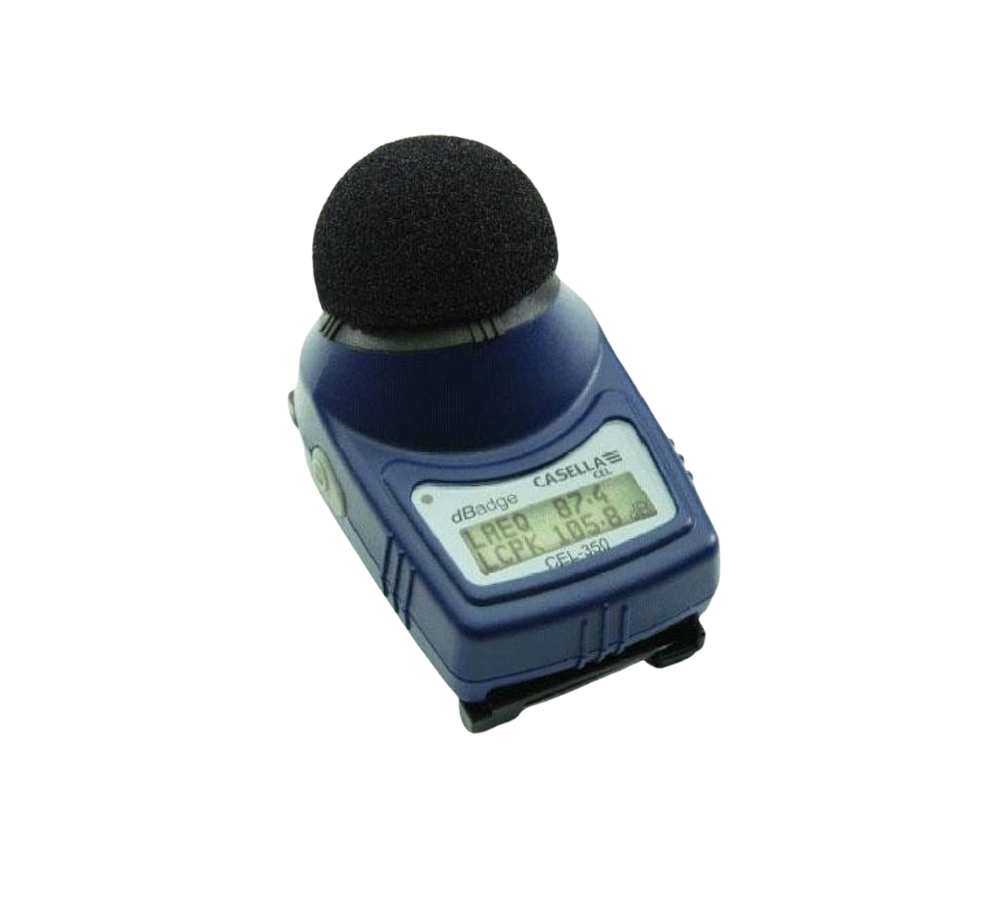 The CEL-350IS is an intrinsically safe, wearable noise dosimeter for measuring personal noise exposure across a work shift.
Designed for hazardous environments, it provides accurate dose, TWA, and time-history data for compliance with OSHA and NIOSH hearing conservation programs.
The CEL-350IS is an intrinsically safe, wearable noise dosimeter for measuring personal noise exposure across a work shift.
Designed for hazardous environments, it provides accurate dose, TWA, and time-history data for compliance with OSHA and NIOSH hearing conservation programs.
- Intrinsically safe. Certified for use in oil & gas, chemical, and industrial plants.
- Wearable convenience. Lightweight and comfortable for continuous shift use.
- Data-rich insights. Tracks time-history and dose for precise exposure analysis.
- Auto-calibration. Simplifies setup and ensures consistent accuracy.
3. Casella CEL-633.A1.K1 Kit—Sound Level Meter
 The CEL-633.A1.K1 is a handheld digital sound level meter for accurate measurement of workplace and environmental noise. It features advanced frequency and time weighting to capture reliable data for compliance reporting and acoustic analysis.
The CEL-633.A1.K1 is a handheld digital sound level meter for accurate measurement of workplace and environmental noise. It features advanced frequency and time weighting to capture reliable data for compliance reporting and acoustic analysis.
- Precision measurement. Captures real-time sound pressure levels with multiple weighting options.
- Smart reporting. Onboard data logging and PC connectivity for analysis and documentation.
- Industrial durability. Rugged design built for demanding field applications.
- Ease of use. Bright, backlit display and intuitive interface for quick setup.
4. RAE Systems MiniRAE 3000 PID — Gas and VOC Monitor
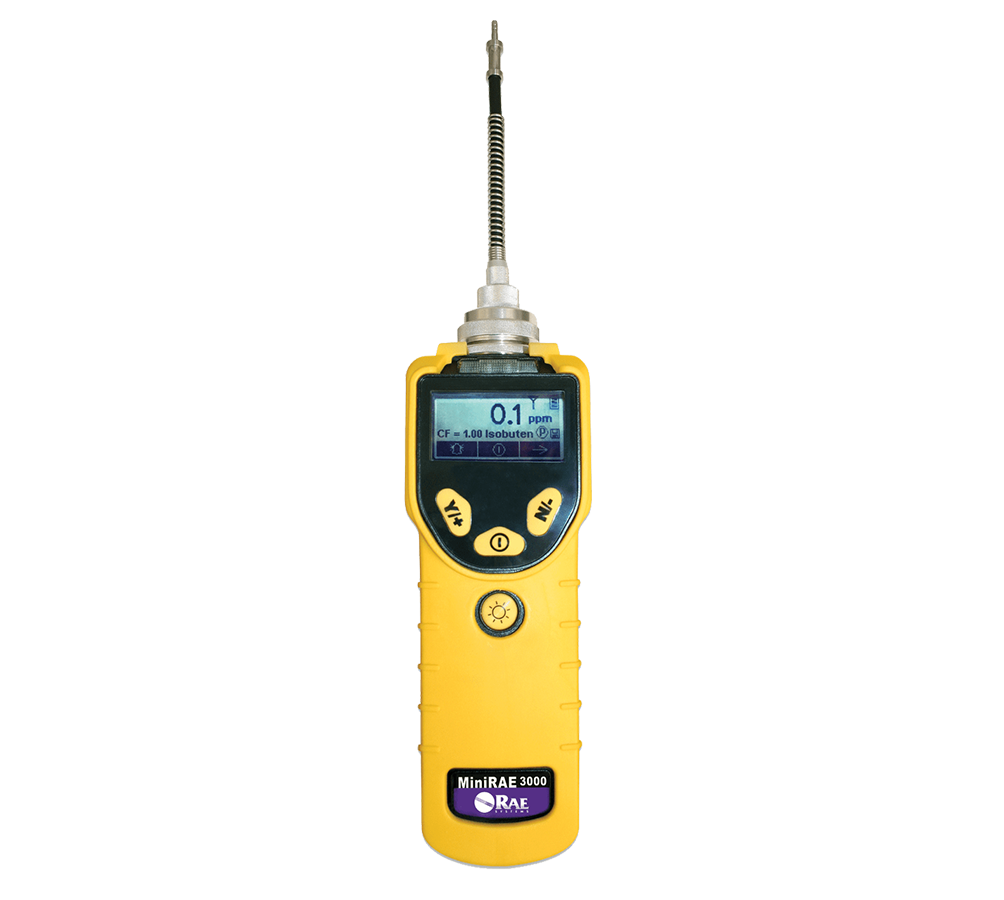 The RAE Systems MiniRAE 3000 is a portable photoionization detector (PID) that measures volatile organic compounds (VOCs) and hazardous gases in real time.
It complements heat and noise monitoring by providing an additional layer of environmental safety for confined spaces and industrial sites.
The RAE Systems MiniRAE 3000 is a portable photoionization detector (PID) that measures volatile organic compounds (VOCs) and hazardous gases in real time.
It complements heat and noise monitoring by providing an additional layer of environmental safety for confined spaces and industrial sites.
- High sensitivity. Detects VOCs from 0.1 to 15,000 ppm for broad-range applications.
- Fast response. Provides real-time readings for leak detection and air-quality assessment.
- Rugged portability. Built for harsh industrial environments with intrinsic safety certifications.
- Data management. Integrated logging and download options for compliance tracking.
What Is a Heat Stress Monitor?
A heat stress monitor is a device that measures how hot a working environment feels to the human body.
It combines temperature, humidity, air movement, and radiant heat data to assess the overall heat load workers experience. By identifying unsafe conditions early, these monitors help prevent heat exhaustion, heat stroke, and other heat-related illnesses.
These tools are widely used in high-heat industries such as construction, oil and gas, manufacturing, and utilities, where workers face prolonged exposure to sun or hot indoor environments. Modern systems often pair sensors with cloud dashboards or mobile apps to provide real-time alerts when readings exceed safe thresholds, giving supervisors and safety officers time to act before heat stress escalates.
Together, these technologies provide a complete picture of heat exposure—both environmental and physiological—helping teams maintain compliance and protect worker health.
Two Types: Personal and Environmental
There are two main types of heat stress monitors: environmental and personal (or wearable).
- Environmental monitors, often referred to as WBGT meters, measure the conditions in the surrounding area to estimate thermal stress.
- Personal or wearable devices track the worker’s physiological response to heat, such as heart rate and skin temperature, providing individualized data on strain and recovery.
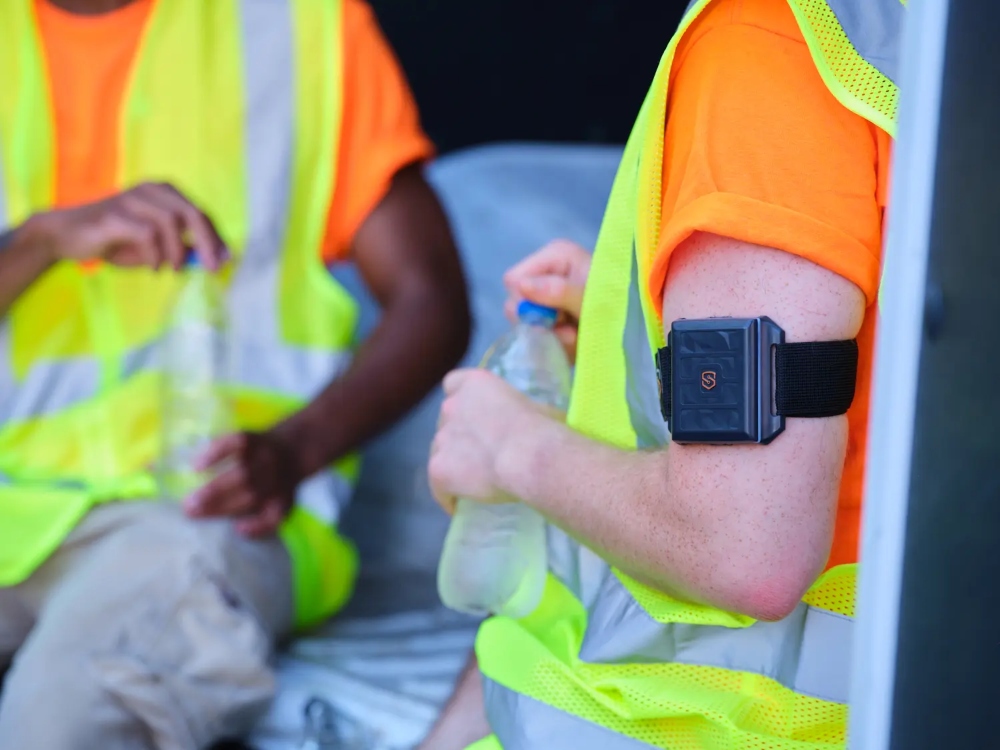
How Heat Stress Monitors Work
Heat stress monitors measure the combined effect of environmental and physiological factors that contribute to heat strain on the body.
They use sensors to track air temperature, humidity, radiant heat, and in some cases, the wearer’s biometric data. By analyzing these inputs, the device estimates the overall heat load a worker is experiencing and signals when conditions become unsafe.
1. Environmental Heat Stress Monitors
Environmental heat stress monitors measure the external factors that influence heat exposure.
Most calculate Wet Bulb Globe Temperature (WBGT), a composite index that combines air temperature, humidity, radiant heat, and airflow to represent total heat load.
Some use the Heat Index or similar algorithms to express perceived temperature, helping safety managers decide when to adjust work-rest schedules or add cooling controls.
- Temperature sensor. Measures ambient or dry-bulb temperature
- Humidity sensor. Captures relative humidity
- Globe sensor. Detects radiant heat from sunlight or hot surfaces
- Airflow sensor. Monitors ventilation and convective cooling
2. Personal and Wearable Heat Stress Monitors
Personal and wearable monitors track the worker’s physiological response to heat.
These systems combine ambient data with biometric readings to estimate core body temperature rise and overall strain. By showing how individual workers respond differently to similar conditions, wearable devices help supervisors identify those at highest risk and intervene early.
- Heart-rate or skin-temperature sensor. Tracks physiological strain
- Motion or activity sensor. Identifies workload intensity
- Wireless connectivity. Transmits data to mobile apps or dashboards
- Alert functions. Signal when personal exposure exceeds safe limits
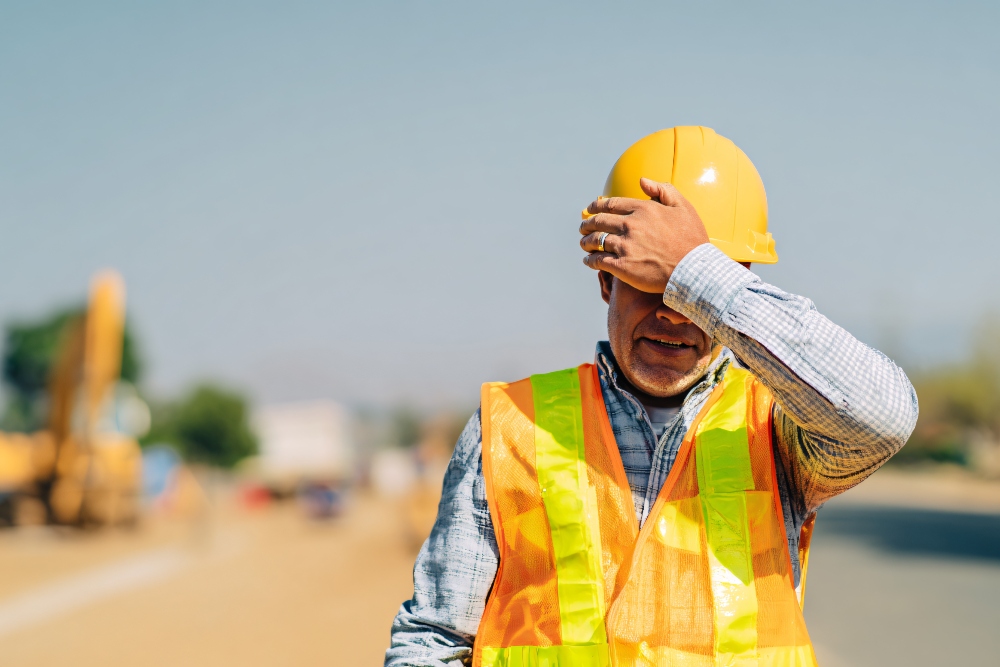
Data Processing and Alerts
Once data is collected using one of the two types of monitors covered above, it’s processed internally or transmitted via Bluetooth/cloud connections to a central monitoring dashboard.
Supervisors can set custom thresholds, view trend data, and receive real-time alerts when workers or areas approach dangerous heat levels. Continuous logging provides defensible documentation for compliance programs and helps refine safety plans over time.
Combined Environmental and Physiological Monitoring
Some advanced heat stress monitors integrate both environmental and personal measurements to provide a complete picture of heat exposure.
These systems merge WBGT readings with heart rate or skin temperature data to show both external stress and internal strain. The combination allows safety teams to make targeted decisions about work pacing, hydration, and rest that protect individuals and optimize overall site productivity.
Types of Heat Stress Monitors
Different types of heat stress monitors are designed for specific environments and applications.
Some track ambient conditions across a worksite, while others monitor the individual worker’s physiological response to heat. Together, they form a complete heat management system that helps prevent illness and meet safety requirements.
Personal / Wearable Heat Stress Monitors
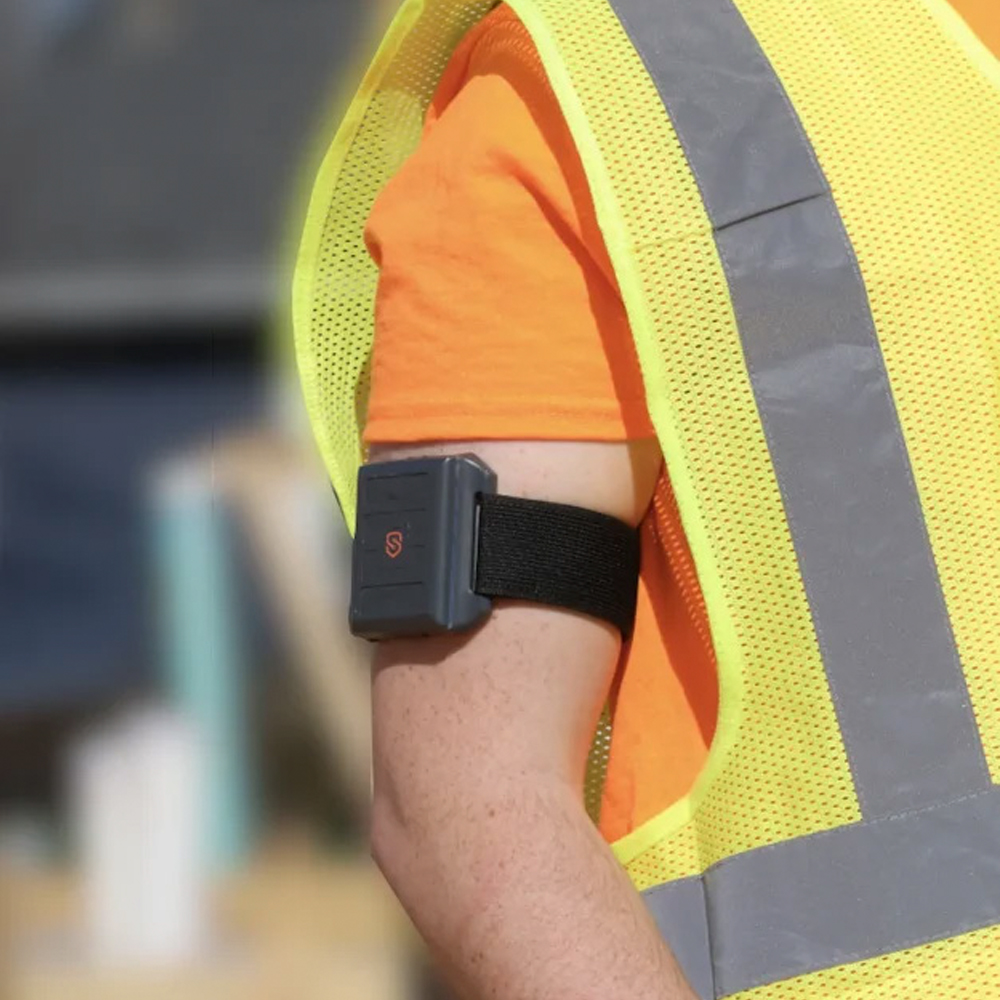
Personal or wearable heat stress monitors measure an individual’s physiological response to heat exposure.
These compact devices are typically worn on the arm, chest, or inside a hard hat and use sensors to capture heart rate, skin temperature, and activity level. Data is analyzed in real time to estimate core body temperature and alert the wearer—or supervisor—when heat strain exceeds safe limits.
- Continuously measures personal heat exposure and recovery
- Provides individualized alerts for early signs of heat stress
- Ideal for mobile workers in construction, utilities, or oil and gas
- Often connects via Bluetooth to safety dashboards or mobile apps
Stationary / Area Heat Stress Monitors
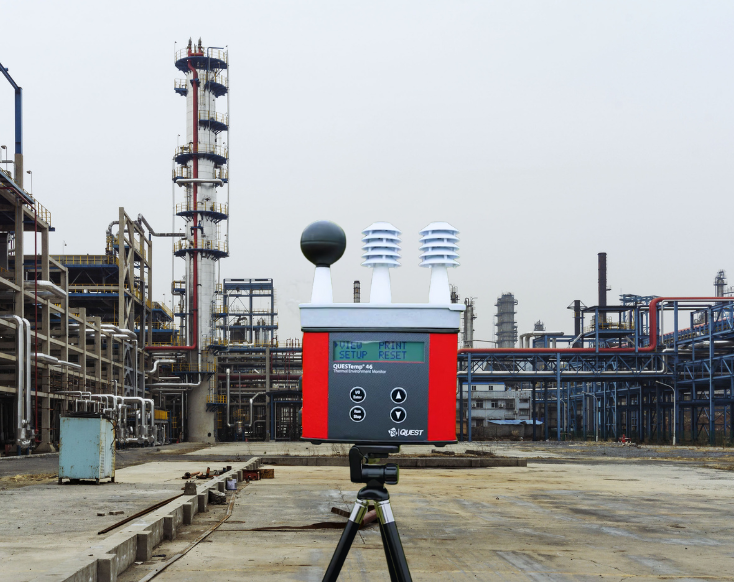
Stationary or area heat stress monitors track environmental conditions in fixed or semi-fixed locations.
They measure parameters like Wet Bulb Globe Temperature (WBGT), humidity, air temperature, and radiant heat to assess the heat load in a specific zone or workspace. These units are common in facilities, refineries, warehouses, and outdoor staging areas.
- Provides continuous readings of environmental heat risk
- Useful for hot work permits and compliance documentation
- Can be mounted on tripods, walls, or weather stations
- Often features alarms, data logging, or wireless reporting
Integrated Systems and Networked Solutions
Integrated systems combine data from both wearable and stationary monitors into centralized safety dashboards. These networked systems allow supervisors to monitor conditions across multiple sites or workers in real time, set custom thresholds, and log data for OSHA compliance or trend analysis.
- Combines environmental and personal data for comprehensive insights
- Supports multiple users or zones through IoT and cloud connectivity
- Enables automated alerts and visualizations for safety teams
- Ideal for large-scale industrial operations and continuous monitoring
How to Use a Heat Stress Monitor
Effective heat stress monitoring helps prevent heat-related illness and supports compliance with evolving OSHA expectations.
A reliable program combines environmental measurements (WBGT, temperature, humidity, radiant heat) with personal data from wearable devices to identify risk early and trigger timely interventions.
Here’s a step-by-step for implementing heat stress meters:
1. Place and Use Monitors Correctly
- Stationary/area monitors. Position at worker height in representative locations. Avoid direct sun on the sensor body unless using a globe sensor designed for radiant heat; use shade or a radiation shield for air temperature sensors. Keep clear of heat sources (machinery exhaust) that don’t reflect typical worker exposure.
- Outdoor sites. Account for microclimates—sun vs. shade, reflective surfaces, wind corridors. Consider multiple monitors across large or varied work zones.
- Indoor sites. Place near hot processes, poorly ventilated areas, and where PPE adds thermal burden (boiler rooms, foundries, kitchens, warehouses).
- Wearables. Assign to workers with highest exposure or critical tasks. Ensure proper fit and sensor contact per manufacturer instructions.
2. Set Measurement Frequency and Logging
Use interval-based readings and continuous logging where feasible. Increase frequency during peak heat, new tasks, or changing weather.
- Log readings at a consistent cadence (e.g., every 15–30 minutes for area monitors, or continuous for wearables).
- Capture conditions during the hottest parts of the shift and after task or location changes.
- Store data in a centralized system (downloadable logs, cloud dashboards) for review, trend analysis, and documentation.
3. Interpret Readings and Set Action Levels
Define caution, warning, and danger thresholds based on recognized guidance (e.g., OSHA, NIOSH, ACGIH TLVs) and your site’s heat-stress policy.
Pair environmental readings with personal indicators to understand actual strain.
- Environmental indicators. WBGT or Heat Index trends moving upward, low wind or poor ventilation, strong radiant heat.
- Personal indicators. Elevated heart rate relative to workload, rising skin temperature, prolonged recovery times, worker-reported symptoms (dizziness, cramps, confusion).
- Actions. Increase rest breaks, add shade or cooling, rotate tasks, provide cool water/electrolytes, adjust PPE or pace.
4. Implement a Heat Stress Monitoring Plan
- Roles and responsibilities. Assign a supervisor or safety lead to review data, configure alerts, and coordinate responses.
- Procedures. Establish when to escalate from caution to work-rest cycles, when to deploy cooling stations or ice towels, and when to stop work.
- Formation. Teach teams how to use devices, recognize symptoms, report concerns, and respond to alarms.
- Acclimatization. Phase in workloads for new or returning workers; monitor closely during the first 7–14 days and heat waves.
- Documentation. Keep logs of readings, alerts, interventions, and outcomes to support incident reviews and compliance audits.
5. Combine Environmental and Personal Data
Use area monitors to set site-wide controls and wearables to tailor protections to each worker.
Integrated dashboards and automated alerts help supervisors prioritize interventions quickly and maintain a defensible record of heat safety practices.
6 Industries that Rely on Heat Stress Monitors
Heat stress monitors are essential in industries where high temperatures, heavy workloads, or bulky PPE increase the risk of heat-related illness.
Monitoring approaches vary by setting—some rely on environmental readings to manage site-wide risk, while others deploy personal or wearable heat stress monitors to track individual exposure in real time.
Here are 6 sectors that rely on heat stress montioring to keep people safe.

1. Pétrole et gaz
Refineries, pipelines, and drilling sites combine radiant heat, confined spaces, and PPE requirements that limit heat dissipation. Heat stress monitors are integrated into safety protocols for turnarounds, shutdowns, and hot work permits.
- Stationary monitors in process areas and tank farms
- Wearable sensors for confined-space entrants and inspection crews
- Automated alerts tied to site-wide safety management systems
- Data collection for incident prevention and post-event analysis
2. Manufacturing
Indoor manufacturing facilities can accumulate radiant and ambient heat from machinery, ovens, and poor ventilation. Heat stress monitors help track thermal load near production lines and verify the effectiveness of ventilation and cooling systems.
- Monitoring temperature and humidity near furnaces or kilns
- Tracking WBGT across multiple zones in large plants
- Using personal monitors for workers in PPE or high-exertion roles
- Logging data for compliance and internal safety audits
3. Services publics et production d'électricité
Power plants and substations often feature high ambient temperatures, radiant load, and minimal airflow. Workers performing maintenance or electrical testing rely on heat stress monitoring to maintain situational awareness and prevent overexertion.
- Continuous WBGT monitoring near turbines, boilers, or transformers
- Wearable heat stress monitors for field technicians and linemen
- Data-driven scheduling to avoid peak-heat hours
- Compliance with internal and OSHA-mandated heat safety plans
4. Mining
Both surface and underground mining present unique thermal challenges. Underground operations trap heat and humidity, while surface operations expose crews to intense sunlight and reflective surfaces. Monitoring systems help balance productivity and worker health.
- Area monitors in tunnels and haul routes for continuous tracking
- Wearables for operators in enclosed cabs or high-heat zones
- Threshold-based alarms to trigger cooling or evacuation protocols
- Integration with ventilation and air-quality monitoring systems
5. Construction
Construction sites face direct sun, radiant heat from concrete and steel, and limited shade, making them prime environments for heat stress monitoring. Supervisors often deploy stationary heat stress meters around active zones and assign personal monitors to workers performing prolonged or high-intensity tasks.
- Monitoring WBGT during paving, roofing, or structural steel work
- Setting work–rest schedules based on rising heat index levels
- Using wearables to track individual exposure for crane or road crews
- Documenting compliance during summer months or government projects
6. Firefighting and Emergency Response
Firefighters and rescue teams face extreme radiant heat, heavy PPE, and high metabolic strain. Wearable heat stress monitors are increasingly used to assess internal body temperature and recovery status during and after operations.
- Monitoring heart rate and skin temperature under turnout gear
- Real-time alerts for overexertion or dehydration
- Post-event data for training and safety analysis
- Integration with command-center dashboards for team oversight
OSHA Regulations and Heat Stress Monitoring
OSHA currently regulates heat hazards under the General Duty Clause (Section 5(a)(1) of the Occupational Safety and Health Act), which requires employers to provide a workplace “free from recognized hazards that are causing or likely to cause death or serious physical harm.”
Although there is not yet a finalized federal heat-specific standard, OSHA has issued detailed guidance on working safely in hot environments and launched a nationwide Heat Illness Prevention Campaign to raise awareness and reduce heat-related incidents.
New Heat Rule Proposed in 2024
On August 30, 2024, OSHA published a Notice of Proposed Rulemaking for a new standard titled Heat Injury and Illness Prevention in Outdoor and Indoor Work Settings.
The proposed rule would require employers to monitor heat exposure, establish written prevention programs, provide rest breaks, ensure acclimatization, and offer worker training. It formalizes best practices already recommended by OSHA, NIOSH, and ACGIH into enforceable federal requirements.
Until the rule is finalized, OSHA continues enforcement under the General Duty Clause and through its National Emphasis Program (NEP) on heat-related hazards. The NEP targets high-risk industries and outlines inspection procedures for evaluating employer heat safety programs.
Key Thresholds at a Glance
| Trigger Level | Metric | Threshold | Required or Recommended Actions | Authority / Reference |
|---|---|---|---|---|
| Initial Heat Trigger | Heat Index | 80 °F | Provide shade, drinking water, rest breaks, and training. | OSHA Proposed Rule (2024) |
| High Heat Trigger | Heat Index | 90 °F | Implement mandatory rest breaks and active monitoring of workers. | OSHA Proposed Rule (2024) |
| Action Limit (Moderate Work) | WBGT | 26.7 °C (80.1 °F) | Initiate heat-stress management program. | ACGIH TLVs |
| Threshold Limit Value (Heavy Work) | WBGT | 30.0 °C (86.0 °F) | Reduce exposure time or increase rest cycles. | ACGIH TLVs |
OSHA, NIOSH, and ACGIH Guidance
- OSHA’s Heat Standards page explains that while no federal standard exists yet, heat stress is enforced under the General Duty Clause using WBGT or Heat Index data as supporting evidence.
- OSHA’s Working in Outdoor and Indoor Heat Environments resource outlines prevention strategies, acclimatization practices, and employer responsibilities.
- Under the proposed rule, “initial heat triggers” (80 °F) and “high heat triggers” (90 °F) will activate mandatory preventive measures including real-time monitoring.
- For updates and rulemaking progress, see the U.S. Department of Labor announcement.
→ See the OSHA Heat Injury and Illness Prevention NPRM et National Emphasis Program (NEP).
How Heat Stress Monitors Support Regulatory Compliance
- Provide continuous, time-stamped WBGT and heat index data to document environmental conditions during OSHA inspections.
- Integrate seamlessly into written Heat Injury and Illness Prevention Plans (HIIPPs) as outlined in OSHA’s proposed rule.
- Trigger alerts and trends that prompt rest breaks, hydration, or cooling measures before exposure reaches hazardous thresholds.
- Meet proposed requirements to “monitor hazards with sufficient frequency to determine exposure” in both outdoor and indoor environments.
- Demonstrate proactive compliance and due diligence under the General Duty Clause by addressing recognized heat hazards with feasible controls.
→ For full regulatory text, visit OSHA’s Heat Exposure Standards page and the 2024 Proposed Rule Summary (PDF).

Heat Stress Monitor Calibration and Maintenance
Accurate readings are essential for assessing workplace heat risk and maintaining defensible safety records. Calibration ensures that each sensor—temperature, humidity, radiant heat, or airflow—provides readings consistent with known reference values. Without regular calibration, data can drift over time, leading to inaccurate assessments and unreliable documentation during inspections or audits.
What Calibration Involves
Calibration compares the monitor’s sensor outputs against certified reference instruments or environmental standards, adjusting as necessary to ensure accuracy. This process confirms that measurements of temperature, humidity, and WBGT remain within accepted tolerances and traceable to recognized standards.
Calibrations may occur at the factory, in a certified laboratory, or through field verification checks performed by trained personnel.
- Factory calibration — performed by the manufacturer or an accredited lab before shipment or at regular intervals.
- Field calibration or verification — performed onsite using reference thermometers, humidity generators, or calibration kits.
- Multi-sensor verification — comparing multiple monitors in identical conditions to identify sensor drift or degradation.
Calibration Intervals at a Glance
| Calibration Type | Interval | Performed By | Objectif |
|---|---|---|---|
| Factory Calibration | Every 12 months | Manufacturer or accredited lab | Ensures full accuracy and traceability to reference standards. |
| Field Verification | Quarterly or start of each season | Qualified technician or safety lead | Checks for sensor drift between factory calibrations. |
| Pre-Use Check | Before each deployment | Operator | Verifies function, battery, and sensor condition. |
Calibration Best Practices
- Follow manufacturer recommendations, typically every 6–12 months depending on use and environment.
- Perform verification checks before each major project or monitoring season.
- Document all calibration activities with date, technician name, and reference instruments used.
- Replace or service sensors that show consistent deviation from expected values.
→ See manufacturer-specific calibration procedures in your device manual and verify traceability to NIST or equivalent reference standards.
Ongoing Maintenance and Care
Regular maintenance extends the life and reliability of heat stress monitors. Proper care includes cleaning sensors, checking battery health, and storing devices under stable conditions when not in use.
- Store monitors in protective cases away from direct sunlight or extreme temperatures.
- Inspect for physical damage, blocked airflow, or degraded cables before each use.
- Keep globe thermometers clean and free of residue to maintain accurate radiant-heat response.
- Replace worn humidity or temperature sensors as part of preventive maintenance.
- Maintain digital calibration and maintenance logs for easy retrieval during audits.
→ Consistent calibration and preventive care ensure defensible data, reliable alerts, and full compliance with OSHA and ISO 7243 requirements.
Calibration Quick Checklist
- Verify all sensors before each deployment.
- Compare readings against a known reference instrument.
- Log calibration dates, reference tools, and corrective actions.
- Clean and inspect sensors after each project or field use.
→ Keeping this checklist visible in the work area helps maintain calibration discipline and audit readiness.
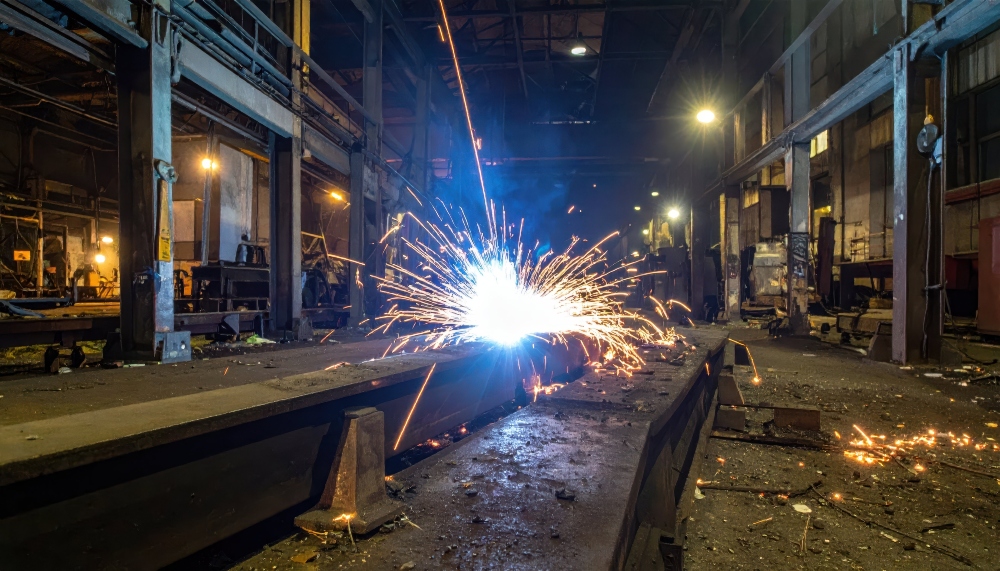
Heat Stress Monitor FAQ
Here are answers to the most commonly asked questions about heat stress montiors.
How do you monitor for heat stress?
Monitoring for heat stress involves measuring environmental and physiological factors that influence how the body responds to heat. Devices such as heat stress monitors or heat stress meters track temperature, humidity, radiant heat, and air movement. Many industrial safety programs also use wearable monitors to measure heart rate and skin temperature, providing real-time alerts before workers reach dangerous thresholds.
What is the new OSHA rule for heat stress?
OSHA is developing a new standard called Heat Injury and Illness Prevention in Outdoor and Indoor Work Settings, which will require employers to implement written heat safety programs, monitoring, training, and rest breaks. While not yet finalized, the proposal was published in 2024 and is expected to become law in the coming years. For current updates, visit OSHA’s Heat Exposure page.
How does a heat stress meter work?
A heat stress meter measures environmental parameters—typically temperature, humidity, radiant heat, and air speed—to calculate indices such as the Wet Bulb Globe Temperature (WBGT). The device combines these inputs to estimate the total heat load on the body, allowing supervisors to identify unsafe conditions and implement controls like rest breaks, shade, and hydration.
What equipment is used to measure heat stress?
Common instruments include handheld or stationary WBGT meters, heat stress monitors, and wearable sensors. These tools measure combinations of air temperature, humidity, radiant heat, and in some cases, physiological indicators like heart rate and skin temperature. Many modern systems integrate with digital dashboards for live monitoring and data logging.
How accurate are wearable heat stress monitors?
High-quality wearable heat stress monitors are highly accurate when properly calibrated and maintained. They use medical-grade sensors to track body temperature and heart rate, paired with environmental data for context. Accuracy may decline if sensors are dirty, misaligned, or used in extreme humidity or vibration, so routine calibration and inspection are essential.
How often should a heat stress monitor be calibrated?
Most manufacturers recommend factory calibration once per year, with field verification checks every few months depending on use intensity. Devices used in harsh environments—such as refineries, foundries, or outdoor sites—may require more frequent calibration to maintain accuracy. Always follow the manufacturer’s calibration schedule and maintain written calibration logs for compliance.
What is the difference between a heat stress monitor and a thermometer?
A standard thermometer measures air temperature alone, while a heat stress monitor measures multiple factors—air temperature, humidity, radiant heat, and airflow—to determine total heat load. Some models also integrate physiological data, providing a more complete picture of environmental and personal risk.
Can heat stress monitors integrate with safety management systems?
Yes. Many modern heat stress monitoring systems include Bluetooth, Wi-Fi, or cloud connectivity for integration with digital safety management platforms. This allows supervisors to receive real-time alerts, visualize trends, and store data for OSHA compliance or internal audits. Integration also supports multi-site monitoring and automated reporting.
What WBGT level is considered dangerous?
According to ACGIH guidelines, WBGT readings above 26–30 °C (79–86 °F) indicate increased heat strain depending on workload and clothing. Levels above 30 °C (86 °F) are generally considered hazardous for continuous heavy labor. Always refer to your organization’s heat safety policy or OSHA’s recommended controls page for site-specific thresholds.
How can I choose the right heat stress monitor for my facility?
Select a heat stress monitor based on your environment, workflow, and compliance needs. For area monitoring, look for WBGT or multi-sensor units with data logging and alarms. For individual monitoring, consider wearable devices that measure physiological response in addition to environmental data. Choose models that can be calibrated, are rugged enough for your setting, and meet recognized standards for industrial use.
